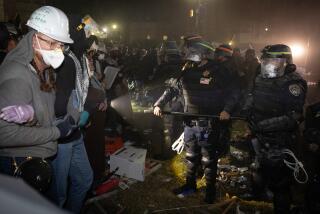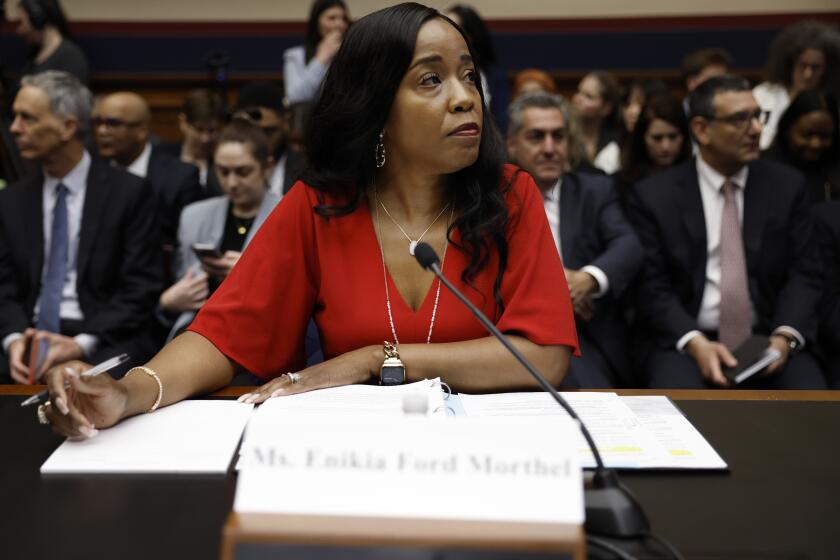Dispute Over State Funding Blurs Outlook for Disabled
When state lawmakers passed the Lanterman Act in 1977, it was hailed as landmark legislation that would enhance the lives of the developmentally disabled.
For some time, it had been widely recognized that those in state hospitals suffering from autism, mental retardation, cerebral palsy and other developmental disabilities could probably lead better lives on the outside--if they only had somewhere else to go.
The act set about to create those places. To encourage the emptying of the state hospitals, the act contained provisions to ensure that parents and others who wanted to start group homes for the disabled would receive enough money from the state to provide quality care.
Result After Nine Years
In one sense, the Lanterman Act is working. Today fewer than 10% of the developmentally disabled--7,000 people--remain in the state hospitals, which are now called developmental centers.
But nine years after its enactment, the act’s custodian, the state Department of Developmental Services, is under attack in the courts and in a confrontation in the Legislature with operators of residential homes for the disabled.
Despite a massive lobbying effort this year in the Legislature, the operators have gotten nowhere in their efforts to get more money for their expenses, which the department acknowledges exceed what the state provides by 14%.
Advocates for the disabled say the freeze on rates would jeopardize the safety of residents and would erode the quality of care being provided.
A bill that would have given a modest 5% rate increase was killed in a state Senate committee last week. The developmental services department refused to support the bill because it would not have been permitted to expand a rate-setting experiment it recently started in three parts of the state. The bill’s author, Assemblyman Gerald N. Felando (R-San Pedro), wanted to limit the expansion because many residential home operators participating in the experiment, including 100 who formed an association, strongly oppose it.
Outlook for Legislation
There appears to be little hope that Felando can resurrect the bill before the legislative session ends this week. Even if he does, the governor probably would veto it, since the developmental services and finance departments oppose the legislation as now written.
This is thought to be the first time that the 4,000 operators of such facilities will have gotten no increase at all since the act became effective eight years ago.
The apparent defeat is particularly bitter for advocates for the disabled because this year more people were involved in the effort than anytime in recent memory.
Thousands of parents wrote letters and sent telegrams to legislators and signed a petition presented to the governor. In hopes that a celebrity might draw more attention to their plight, organizers got Stasha Stallone, the former wife of actor Sylvester Stallone and the parent of an autistic son, to be their spokesman. And this spring, 250 disabled children and adults gathered in front of the governor’s district office in Los Angeles and waved protest signs.
Advocates for the disabled are now pinning their hopes on three lawsuits filed in Los Angeles Superior Court alleging that the department has violated the Lanterman Act by using flawed data when setting rates.
According to the plaintiffs--charities, private providers, a national autistic organization and the disabled themselves--the state’s methodology makes it appear that it is cheaper to run a group home than it really is. The plaintiff’s attorneys say flawed data is also being used as the foundation for the department’s rate experiment.
The department is ignoring some of the costs a home incurs that the Lanterman Act requires be considered when rates are set, said Valerie Vanaman, a Sherman Oaks attorney who filed two of the lawsuits.
“This is the most phenomenal department I’ve ever dealt with,” Vanaman said. “They don’t seem to be concerned with what the law says.”
For example, Vanaman said, the act requires the state to take geography into account when computing rates. Obviously, housing in Los Angeles or San Francisco costs more than it does in Yuba City or Redding, so the operators in the urban areas should receive more money, she said.
Differences Unclear
That does not happen now. Department officials say that is because they have been unable to pinpoint what the differences in real estate costs are throughout the state.
“It’s impossible to pay for a geographic difference if we can’t identify what it is,” said Phyllis Cadei, an assistant department director.
Low rates, the plaintiffs contend, have forced some providers to close their doors or go deeply into debt. The belt-tightening, they allege, is endangering the welfare of the 15,000 people living in community facilities. And they maintain that an unfair rate system that has curbed efforts to find home placements for the disabled is the reason the state has failed in the past two years to discharge as many patients from state hospitals as it would have liked.
Department officials acknowledge that the money given to clothe, feed, shelter and train the developmentally disabled living in the community has not been enough. The rates range from roughly $500 to $3,000 a month per person, depending on the severity of a resident’s handicaps.
Agreement on Rates
“There is no question we all agreed we needed to do something with the rates. Without an increase, it will put a further pinch on the operators,” said Al Lee, the department’s chief deputy director.
The department says costs are outpacing the rates by 14%. The State Council on Developmental Disabilities, which by law is required to review the rates paid, places the gap at 20%.
Department officials, however, say there is nothing illegal about how the department determines the rates.
Lee said that, in any case, the community homes will be much better off once the department fully implements the new method of setting rates that is now being used on an experimental basis. Basically, the new method applies an overall rate for facilities, rather than a per resident rate. Also, department officials added, the method is fairer because it more accurately identifies expenses and reimburses caretakers accordingly.
No Improvement Seen
But Dan Stormer, one of two Los Angeles attorneys who filed the suits on behalf of the disabled, contends that the department’s new rate schedule is just as bad as the current one.
Without the prospect of a rate increase this year, disabled advocates say an already intolerable situation will get worse.
“Some folks will go out of business,” predicted Lonnie Nolta, chief director of advocacy services for United Cerebral Palsy Assn. of California. “Some have already made arrangements to put their homes on the market.”
To survive, some of the administrators who are responsible for the safety of 15,000 developmentally disabled children and adults living in community-based facilities in California are already cutting corners.
Revelation at Hearing
An administrator of the Jay Nolan Center in Saugus, a nationally reknowned center for emotionally disturbed autistic adults, made one such admission at a public hearing recently. Some residents, the administrator said, were kept on medications because there was not enough staff to handle their unleashed aggressiveness. The administrator of another large facility in Pomona said when he tried cutting his staff to save money last year, suicide attempts among the autistic residents increased.
United Cerebral Palsy documented home operators’ financial difficulties earlier this year when it surveyed the operators of 137 big and small facilities scattered across the state. Eighty-seven of the agencies were in debt, generating a total monthly deficit of $334,000, the study found. Also, nine operators already had closed their doors and 16 others were contemplating it.
United Cerebral Palsy, one of the state’s largest providers and a top fund-raiser in the field, shocked many in the business this year when it shut down one of its smaller homes in Los Angeles. The charity, which must raise $2 million annually to keep the doors of its many facilities open, could not afford to raise its debt ceiling, said Ronald Cohen, the association’s director of program services.
“If United Cerebral Palsy of Los Angeles had to close a program, the writing is on the wall,” Cohen said. “The providers are in trouble.”
Aid from Scientist
One of those people trying to save a residential home is Stanford University Professor Arthur L. Schawlow, a Nobel Prize winner who used his award money to rescue a bankrupt home for autistic adults in Cypress.
Schawlow, a pioneer in laser technology, won the Nobel Prize for physics in 1981. He and his wife took the $45,000 in prize money and another $100,000 they obtained through mortgaging their house and spent it on a group home where Artie, their 30-year-old autistic son, lives.
Three successive operators of the facility had declared bankruptcy, in part because the state had not provided enough money to keep it solvent, the Nobel laureate said.
When no one expressed an interest in the home after the last bankruptcy, the Schawlows stepped in to save it.
“You do what you can for your child. I don’t mind, but I’m 65 and I’m not going to live forever,” said Schawlow, who formed a nonprofit organization with friends to operate the 26-bed facility. “When I look to the future, I think the state should assume the burden. I know that there are many who can’t do what we do.”
Officials Skeptical
But department officials who were interviewed say they are skeptical when they listen to some of these hard-luck stories. The department’s statistics do not indicate that a crisis exists, they say.
Department officials also question the validity of United Cerebral Palsy’s much-talked-about survey. They said the charity only sampled a fraction of the state’s 4,000 nonprofit and proprietary providers and, besides, they suggest, the questions were slanted.
“It wasn’t an academic survey,” assistant department director Cadei said. “It was a survey that asked, ‘Do you get paid enough?’ ”
The department’s own research does not paint such a dreary picture. An agency survey in April indicated that 136 facilities closed in the previous 12-month period, but only four closed because of insufficient rates, said Beverly Canfield, community program specialist.
More Transfers Planned
For the department, the providers’ disillusionment comes at a bad time. In 1984, the department announced that it wanted to move 3,700 more residents of developmental centers into the community in the next five years. The state, however, cannot meet its goal without luring new people into the field and convincing the existing operators to expand.
The task the state set for itself is all the more difficult because the majority of those left behind in the state’s eight developmental centers have the most severe handicaps. Some are blind and profoundly retarded. Others are prone to rage and self mutilation. Some have little or no control over their arms and legs.
The department’s goal was to place 1,550 people during the past two years. It found places for 1,219. During the same period, 788 people entered the developmental centers.
It is getting impossible to find anyone willing to expand their facilities, observed Sandra Virago, the executive director of the Assn. of Regional Center Agencies. The association represents the state’s 21 regional centers--nonprofit governing boards which contract with the Department of Developmental Services to find housing, health care and educational programs for developmentally disabled.
“Every regional center certainly has the perception that . . . (providers) are reticent to start new programs when there is an unknown about whether they will be in the black,” she said.
Many Seek Openings
One of the nonprofit organizations which has declined in the past to expand for monetary reasons is the Jay Nolan Center in Saugus, which specializes in treating autistic adults with severe behavioral problems.
Every week, Tom Thompson, the executive director, gets two or three calls from parents pleading to get their children into his facility. For awhile this year, one woman from Northern California parked her trailer next to the center and vowed to wait until there was an opening.
But the center’s nine group homes housing 46 teen-agers and adults are always full and there are several hundred people on the waiting list. The state offered to award Thompson a grant to help defray the costs if he started two more six-bed homes. The center’s board of directors reluctantly declined because the center already generates a $300,000 debt each year. The money must be made up through fund-raising.
This summer, an architect from Northern California and a retired couple from Orange County, anxious to get their two children into Jay Nolan, agreed to buy the charity two houses. The parents also agreed to reimburse Thompson for the expenses not covered by the state.
Moratorium Urged
The financial instability of some community facilities worries the parents of children who remain in the developmental centers. A statewide parents’ group asked the state to temporarily place a moratorium on moving out anymore institutionalized residents, said Matthew J. Guglielmo, a board member from San Marino.
“Until the department of developmental services does something to improve the quality of the facilities in the community . . . we don’t want our children to move,” said Guglielmo, whose profoundly retarded 24-year-old daughter, Annie, lives at Fairview Developmental Center.
But Lee said the request is out of the question. Confining people in state hospitals when they could be living in the community would disregard a nationwide trend and would represent “a throwback to the ‘50s,” he said.
More to Read
Get the L.A. Times Politics newsletter
Deeply reported insights into legislation, politics and policy from Sacramento, Washington and beyond. In your inbox three times per week.
You may occasionally receive promotional content from the Los Angeles Times.






